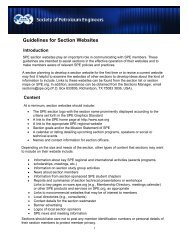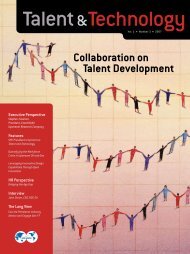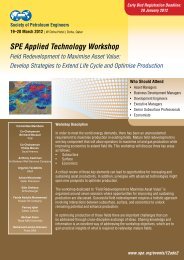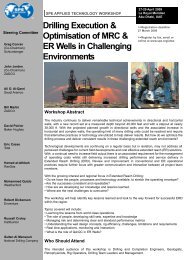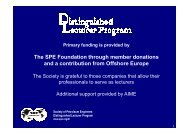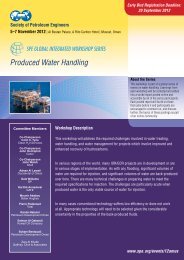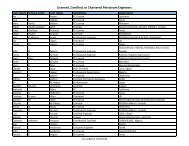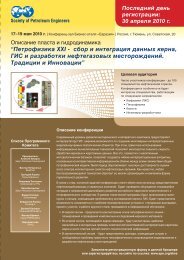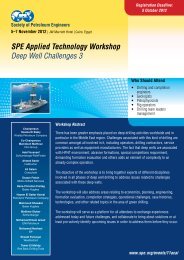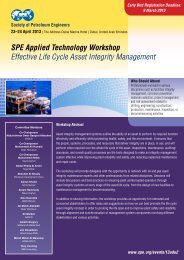SPE/WPC/AAPG/SPEE Petroleum Resources Management System ...
SPE/WPC/AAPG/SPEE Petroleum Resources Management System ...
SPE/WPC/AAPG/SPEE Petroleum Resources Management System ...
You also want an ePaper? Increase the reach of your titles
YUMPU automatically turns print PDFs into web optimized ePapers that Google loves.
<strong>SPE</strong>/<strong>WPC</strong>/<strong>AAPG</strong>/<strong>SPE</strong>E <strong>Petroleum</strong><br />
<strong>Resources</strong> <strong>Management</strong> <strong>System</strong> (PRMS)<br />
PRMS<br />
Prepared by the <strong>SPE</strong> Oil & Gas Reserves Committee (OGRC)<br />
1
Who<br />
is the OGRC?<br />
International representation<br />
(USA, Canada, Australia, UK, Italy,<br />
Hungary, Saudi Arabia)<br />
Focus on technical standards<br />
Inter-organizational cooperation<br />
2
<strong>SPE</strong> “Vision” for Reserves/<strong>Resources</strong><br />
• <strong>SPE</strong>/<strong>WPC</strong>/<strong>AAPG</strong>/<strong>SPE</strong>E definitions and classification<br />
system (and associated estimating guidelines) will continue<br />
to be maintained evergreen and enhanced to incorporate<br />
new best practices, and unconventional resources, and will<br />
be recognized as the premier classification standard.<br />
• <strong>SPE</strong> will actively promote and facilitate in-depth<br />
understanding of the definitions and their universal<br />
adoption by the oil, gas, and related industries; international<br />
financial organizations; governments; regulatory agencies;<br />
and reporting bodies.<br />
3
Securities<br />
Regulators<br />
Investors<br />
Our Stakeholders<br />
Oil & Gas<br />
Companies<br />
small independents Large IOC’s and NOC’s<br />
Financial<br />
Organizations<br />
Government<br />
Agencies<br />
All stakeholders require complete, consistent and reliable<br />
information on future production and associated cash flow<br />
estimates through full life recovery.<br />
4
Prospect<br />
Generation<br />
Wildcat<br />
Drilling<br />
Scope of Projects<br />
Align with the hydrocarbon finding, developing<br />
and producing business!<br />
E&P Life Cycle<br />
We require a system that will<br />
support assessment<br />
processes throughout the<br />
asset lifecycle<br />
Discovery,<br />
Appraisal,<br />
Development<br />
Field<br />
Optimization<br />
Enhanced<br />
Recovery<br />
Decline,<br />
Abandonment<br />
+<br />
+<br />
+<br />
5
Evolution of <strong>Petroleum</strong> Evaluation Guidelines<br />
API 1936<br />
API/AGA 1961<br />
<strong>SPE</strong>/API 1964<br />
<strong>SPE</strong>E 1985<br />
<strong>WPC</strong> 1987<br />
<strong>SPE</strong> 1987<br />
1997 <strong>SPE</strong>/<strong>WPC</strong> <strong>Petroleum</strong> Reserves Definitions<br />
2000 <strong>SPE</strong>/<strong>WPC</strong>/<strong>AAPG</strong> <strong>Petroleum</strong> <strong>Resources</strong><br />
Classification and Definitions<br />
2001 <strong>SPE</strong>/<strong>WPC</strong>/<strong>AAPG</strong> Guidelines for the<br />
Evaluation of <strong>Petroleum</strong> Reserves and <strong>Resources</strong><br />
2005 <strong>SPE</strong>/<strong>WPC</strong>/<strong>AAPG</strong> Glossary of Terms<br />
2007 <strong>SPE</strong>/<strong>WPC</strong>/<strong>AAPG</strong>/<strong>SPE</strong>E<br />
<strong>Petroleum</strong> <strong>Resources</strong><br />
<strong>Management</strong> <strong>System</strong><br />
(<strong>SPE</strong>-PRMS)<br />
Consolidate, build on, update, and replace prior guidance<br />
6
Securities<br />
Disclosures<br />
Government<br />
Reporting<br />
International<br />
Standards<br />
<strong>SPE</strong> Mapping Project<br />
Agencies Selected for Comparison<br />
1. US Securities and Exchange Commission (SEC-1978)<br />
2. UK Statement of Recommended Practices (SORP-2001)<br />
3. Canadian Security Administrators (CSA -2002)<br />
4. Russian Ministry of Natural <strong>Resources</strong> (RF-2005)<br />
5. China <strong>Petroleum</strong> Reserves Office (PRO-2005)<br />
6. Norwegian <strong>Petroleum</strong> Directorate (NPD–2001)<br />
7. United States Geological Survey (USGS-1980)<br />
8. United Nations Framework Classification (UNFC-2004)<br />
(see final report December 2005 on <strong>SPE</strong>.org)<br />
7
PRMS - Major Principles<br />
1. The <strong>System</strong> is “Project–Based”.<br />
2. Classification is based on project’s chance of commerciality.<br />
Categorization is based on recoverable uncertainty.<br />
3. Base case uses evaluator’s forecast of future conditions.<br />
4. Applies to both conventional and unconventional resources<br />
8
project<br />
lease<br />
reservoir<br />
How much<br />
is there?<br />
Reservoir<br />
(in-place volumes)<br />
What is my share of<br />
costs and revenues?<br />
“Project-Based” <strong>System</strong><br />
net<br />
recoverable<br />
resource<br />
Property<br />
(ownership/contract terms)<br />
What is my entitlement<br />
using this project?<br />
Project<br />
(production & cash flow<br />
schedules)<br />
9
Separate Classification & Categorization<br />
Discovered<br />
Undiscovered<br />
Sub-commercial Commercial<br />
Production<br />
Reserves<br />
Contingent<br />
<strong>Resources</strong><br />
Unrecoverable<br />
Prospective<br />
<strong>Resources</strong><br />
Unrecoverable<br />
categorize estimates based on uncertainty<br />
of sales quantities associated with project<br />
classify by<br />
Chance of<br />
Commerciality (Risk)<br />
of project applied<br />
chance of<br />
development<br />
chance of<br />
discovery<br />
reservoir in-place uncertainty +<br />
project recovery efficiency<br />
10
<strong>Resources</strong> Classification <strong>System</strong><br />
Total Initially-in-Place (IIP)<br />
Discovered IIP Undiscovered IIP<br />
Sub-<br />
Commercial<br />
Unrecoverable<br />
Recoverable<br />
Commercial<br />
Recoverable<br />
Potentially<br />
Commercial<br />
Unrecoverable<br />
TOTAL PETROLEUM INITIALLY-IN-PLACE (PIIP)<br />
DISCOVERED PIIP<br />
UNDISCOVERED PIIP<br />
COMMERCIAL<br />
SB-COMMERCIAL<br />
Proved<br />
Low<br />
Estimate<br />
PRODUCTION<br />
RESERVES<br />
1P 2P<br />
Probable Possible<br />
CONTINGENT<br />
RESOURCES<br />
1C 2C 3C<br />
UNRECOVERABLE<br />
PRO<strong>SPE</strong>CTIVE<br />
RESOURCES<br />
Best<br />
Estimate<br />
UNRECOVERABLE<br />
Range of Uncertainty<br />
3P<br />
High<br />
Estimate<br />
Increasing Chance of Commerciality<br />
Not to scale<br />
11
Discovered<br />
<strong>Resources</strong> Class Criteria<br />
Established through testing, sampling and/or logging the existence of a<br />
significant quantity of potentially moveable hydrocarbons.<br />
Commercial<br />
• Meets evaluator’s economic criteria<br />
• No significant contingencies that would prevent development<br />
• Reasonable expectation that all internal/external approvals will be forthcoming<br />
• Intent to initiate development within a reasonable time frame<br />
“ reasonable time frame” depends on the specific circumstances and varies according to<br />
the scope of the project.<br />
12
Commercial<br />
Criteria<br />
Sub-classify by Project Maturity<br />
Discovery<br />
Criteria<br />
TOTAL PETROLEUM INITIALLY-IN-PLACE (PIIP)<br />
DISCOVERED PIIP<br />
UNDISCOVERED PIIP<br />
COMMERCIAL<br />
SUB-COMMERCIAL<br />
PRODUCTION<br />
RESERVES<br />
CONTINGENT<br />
RESOURCES<br />
UNRECOVERABLE<br />
PRO<strong>SPE</strong>CTIVE<br />
RESOURCES<br />
UNRECOVERABLE<br />
Range of Uncertainty<br />
Project Maturity<br />
Sub-classes<br />
On Production<br />
Approved for<br />
Development<br />
Justified for<br />
Development<br />
Development Pending<br />
Development Unclarified<br />
or On Hold<br />
Development<br />
not Viable<br />
Prospect<br />
Lead<br />
Play<br />
Not to scale<br />
Increasing Chance of Commerciality<br />
13
Reserves Status<br />
Additional Classification Modifiers<br />
Recoverable quantities my be subdivided based on the funding and operational<br />
operational status of wells and associated facilities into:<br />
Developed (Producing or Non-Producing)<br />
Undeveloped<br />
Reserves status may be applied to Proved, Probable and Possible<br />
Economic Status<br />
Projects may be further characterized by economics and commercial modifiers into:<br />
Economic (Reserves)<br />
Marginal Economic (Contingent <strong>Resources</strong>)<br />
Sub-Marginal Economic (Contingent <strong>Resources</strong>)<br />
“Reserves” and “Economic” Status may be applied separately<br />
or in combination with Project Maturity Sub-classes<br />
14
EUR<br />
Cum Prod<br />
Proved Probable Possible<br />
Categorize by Uncertainty<br />
The system accommodates multiple approaches to assessing uncertainty.<br />
Deterministic Methods<br />
incremental<br />
reasonably certain<br />
1P scenario – high degree of confidence<br />
Less likely than Proved<br />
More Likely than Possible<br />
2P scenario – more likely than not<br />
Less likely than Probable<br />
3P scenario - unlikely<br />
1P<br />
2P<br />
3P<br />
scenario<br />
% probability of value or more<br />
100%<br />
0%<br />
Probabilistic Methods<br />
cum prod<br />
Proved<br />
P90<br />
1P 2P 3P<br />
EUR<br />
Probable<br />
P50<br />
Possible<br />
P10<br />
15
Based on Forecast Conditions<br />
Project decisions are based on the evaluators view of “Forecast Conditions”<br />
= those assumed to exist during the project’s implementation<br />
Conditions include: •Prices and costs<br />
•Technology available<br />
•Environmental standard<br />
•Fiscal terms<br />
•Regulatory constraints<br />
COMMERCIAL<br />
PROVED<br />
“forecast case”<br />
1P 2P 3P<br />
RESERVES<br />
PROBABLE POSSIBLE<br />
Alternate economic scenarios are typically considered in the decision process<br />
and, in some cases, to supplement reporting requirements.<br />
For example, one sensitivity case may assume “current conditions” will remain constant<br />
throughout the life of the project (“constant case”).<br />
16
Unconventional <strong>Resources</strong><br />
Oil Shale<br />
Extra -Heavy<br />
Oil<br />
Bitumen<br />
Heavy<br />
Oil<br />
Conventional<br />
Reservoirs<br />
Unconventional<br />
Reservoirs<br />
Tight Gas<br />
Sands<br />
Increasing In-Place Volume<br />
Gas Shales<br />
Coalbed<br />
Methane<br />
Gas Hydrates<br />
Pervasive over large areas and not significantly affected by current<br />
hydrodynamic influences, i.e. buoyancy of petroleum on water!<br />
<strong>SPE</strong> classification still applies (but may require alternative assessment approaches).<br />
17
PRMS Development and Approval “Process”<br />
OGRC<br />
Definitions Revision<br />
Project - Phase 1<br />
Sept 2004 – Oct 2006<br />
Final Approval<br />
March 2007<br />
100 Day Industry<br />
Review Period<br />
(30 presentations –<br />
global feedback)<br />
Submit for <strong>SPE</strong> board and<br />
partner approval<br />
OGRC reviews/incorporates<br />
feedback into a final PRMS<br />
18
Summary of Major Changes in 2007<br />
<strong>SPE</strong>/<strong>WPC</strong>/<strong>AAPG</strong>/<strong>SPE</strong>E PRMS<br />
Revision<br />
Combines 4 previous documents into single "<strong>Petroleum</strong> <strong>Resources</strong> <strong>Management</strong> <strong>System</strong>":<br />
1997 <strong>SPE</strong>/<strong>WPC</strong> <strong>Petroleum</strong> Reserves Guidelines<br />
2000 <strong>SPE</strong>/<strong>WPC</strong>/<strong>AAPG</strong> <strong>Petroleum</strong> <strong>Resources</strong> Classification and Definitions<br />
2001 <strong>SPE</strong>/<strong>WPC</strong>/<strong>AAPG</strong> Guidelines for the Evaluation of <strong>Petroleum</strong> Reserves & <strong>Resources</strong><br />
2005 <strong>SPE</strong>/<strong>WPC</strong>/<strong>AAPG</strong> Glossary of Terms<br />
Base case uses forecast conditions but still permits option to use constant conditions<br />
Recognizes growing importance of unconventional resources<br />
Low, mid and high categories of Contingent <strong>Resources</strong> relabeled to 1C, 2C & 3C respectively<br />
Introduces classification modifiers:<br />
- Reserves status of developed and undeveloped can be applied to 1P, 2P & 3P Reserves<br />
- Reserves, Contingent <strong>Resources</strong> & Prospective <strong>Resources</strong> sub-classified by project maturity<br />
- Contingent <strong>Resources</strong> subdivided into 'marginal economic' & 'sub-marginal economic'<br />
Comment<br />
Separate documents combined,<br />
abbreviated and clarified<br />
Most companies base decisions on<br />
forecast conditions; some<br />
regulators require constant<br />
conditions for consistent reporting<br />
PRMS applies to both conventional<br />
and unconventional resources<br />
Aligns with 1P, 2P & 3P Reserve<br />
uncertainty categories but constrained<br />
by commerciality barrier(s)<br />
Additional classification modifiers<br />
optional but may greatly assist in<br />
understanding and tracking reserves<br />
and resources<br />
19
Total Resource <strong>System</strong> is “Project-Based”<br />
PRODUCTION<br />
Proved<br />
Probable Possible<br />
Contingent <strong>Resources</strong><br />
No Project – No recoverable resource<br />
Prospective <strong>Resources</strong><br />
categorize by recovery certainty<br />
The key is the<br />
PROJECT<br />
Discovered<br />
Undiscovered<br />
Commercial<br />
Sub-commercial<br />
20<br />
classify by commercial certainty
What’s Next?<br />
Education Programs (ATW’s, JCORET, …)<br />
Implementation Guides, Examples<br />
Collaboration with Other Standards<br />
21






